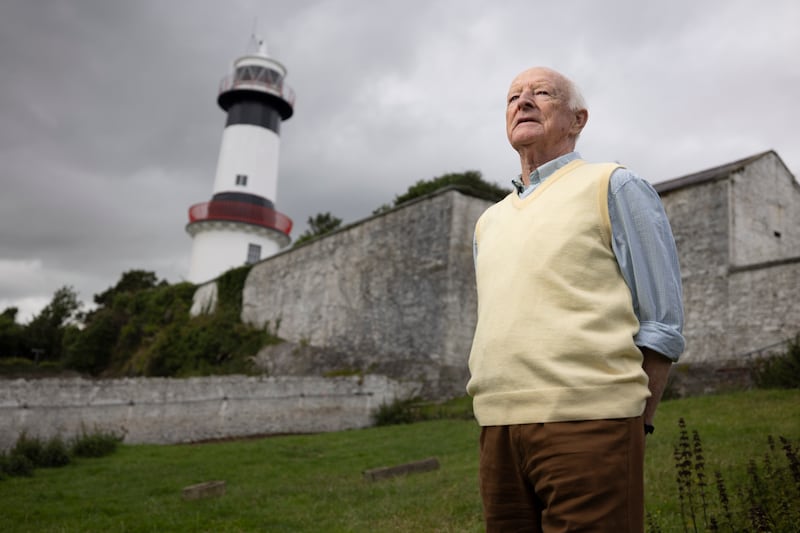For centuries, Ireland’s lighthouses have stood strong against raging storms, offering a beacon of hope for sea travellers and carrying a strange fascination for those on land. In a new series, The Irish Times visited some of Ireland’s most notable lighthouses, including Blacksod, Fanad, Ballycotton, Hook, and Wicklow Head, to learn about their fascinating histories and how their roles have changed in the modern era.
Eugene O’Sullivan remembers being posted to the Blackrock lighthouse in Co Mayo as a young man.
Back then, the only means of access was by currach, as the sea swell was too dangerous and unpredictable for larger boats to manage. The only way on and off the currach was to cling to a rope that was winched over and back.
One December 18th, O’Sullivan and another lighthouse keeper landed safely along with two live ducks they had been given as a present to be eaten on Christmas Day. One of the colleagues they were replacing was so enthusiastic about his leave that he ended up misjudging his landing and going into the water.
“He had a postbag on his back and all you could see was it trailing behind him as he headed to the bottom of the sea and his cap floating on the water,” says O’Sullivan.
The 83-year-old chuckles at the memory of the keeper eventually resurfacing before he “turned the water blue” due to his anger towards whoever had winched him off the rocks.

At least he was luckier than the ducks, who didn’t survive their visit. After feeding them corn for a week, says O’Sullivan, they were more like pets than Christmas dinner. “You’d never do it now,” he says, recalling how the two keepers faced into wringing the birds’ necks, knowing “it was dead duck or no dinner”.
As the last principal lighthouse keeper at the Baily on Howth Head when the service became fully automated in 1997, he had reason to take stock. He and two of his brothers, Donal and Hugh, followed their father, DJ, a published poet “discovered” by fellow poet Austin Clarke and an Irish Press nature columnist of 40 years, into the service.
DJ’s father and grandfather had also been lighthouse keepers, with the family tradition extending from the 1800s.
“My great-grandfather was based on Rathlin Island,” says O’Sullivan. “He must have been in the British army because he was employed as a gunner.”

A fog signal was established in 1866, consisting of an 18lb gun, which was fired every 20 minutes during fog. This was replaced by an explosives-based fog signal in 1918.
O’Sullivan’s grandfather was serving as a lighthouse keeper on the Bull Rock off west Co Cork in 1917 when he drowned while fishing. DJ O’Sullivan was 11 at the time, and the eldest of five, but his mother had to move them out of the lighthouse keeper’s accommodation to make way for the family of the man replacing her husband.
“They had three weeks to get out of the house,” he says. “They had nothing.”
The smell of paraffin oil, which was used for the lights before electricity, is his earliest lighthouse memory, dating from visiting his father while he was stationed at Inishowen.
Like DJ, who immortalised the place in poems, Eugene has a special affection for Inishtrahull Island, north of Malin Head, with its “peace and quiet” and ample space for gardening in the company of an array of seabirds.
He never served alongside his father or two brothers, but they had many shared memories of stunning outposts such as Fastnet, Eagle Island and Inishtearaght Lighthouse on the Blasket islands.
“It was hard to get on and hard to get off it,” he says of the Blaskets. “We went from Castletownbere in a boat with great boatmen. It was about 40 miles.”
The arrival of helicopters and deep freezers transformed the lives of those in the service, he adds.
The only time “you’d be a bit anxious”, says O’Sullivan, was on the boat journey to some of the more inaccessible lighthouses perched on precarious clifftops or piles of jagged, inhospitable rocks.
“Once you were in the lighthouse you were never scared,” he adds. However, he does recall an occasion on Aranmore Island off Burtonport, Co Donegal when he was having a cup of coffee with the other keeper and the raging sea broke the windows. “But that was very rare.”
Another Co Donegal posting was to Tory Island, where O’Sullivan remembers going for long walks and never meeting any of the inhabitants. “They used nearly sleep during the day and come out at night.”

One local he befriended was fisherman James Dixon, who started painting in his 70s and whose work can be found now in the Hugh Lane gallery in Dublin and in the Arts Council’s collection. He also knew the renowned British-born painter Derek Hill, who spent summers painting on Tory and who reputedly encouraged Dixon.
“The yarn is Derek Hill offered him paint and brushes but he made his own paint brush out of a donkey’s tail,” says O’Sullivan, proud owner of a few Dixon paintings.
Having never married, O’Sullivan says he was never lonely while doing six-week stints in lighthouses but he can understand how difficult it might be for men whose families did not live alongside them. “I think you could be more lonely in a crowd. But it wasn’t an easy life for some.”
“Being responsible for the safety of passing ships could also take its toll,” he says.
“You kept a log and, in the winter time, if you saw fishing boats going down into a trough you’d be wondering if they were going to come back up again. You’d watch them until they went out of sight. When we started off there were no radios and no telephones to the lighthouse.”
When he finished up, O’Sullivan felt it was the end of an era as, like many lighthouse families, his had a long history.
“It was an emotional day for me,” he says. “I thought this must be 150 years since we started in the lights.”
- Sign up for push alerts and have the best news, analysis and comment delivered directly to your phone
- Join The Irish Times on WhatsApp and stay up to date
- Listen to our Inside Politics podcast for the best political chat and analysis


















